Topics
Category
Era
Oliver Iron Mining Company
Oliver Mining Company steam-powered shovel near Hibbing, 1919. In this method of mining, a shovel removes overburden, the rock and soil that covers the ore body, so that miners can access the ore from the open pit.
The Oliver Iron Mining Company was one of the most prominent mining companies in the early decades of the Mesabi Iron Range. As a division of United States Steel, Oliver dwarfed its competitors—in 1920, it operated 128 mines across the region, while its largest competitor operated only sixty-five.
After the Merritt brothers began shipping iron ore from their Mountain Iron mine in 1892, Henry Oliver, a Pittsburgh businessman, traveled to the Iron Range to consider investing in the fledgling industry. Impressed by what he saw, Oliver offered to purchase one of the ore deposits for $75,000 and 65 cents per ton of ore mined. The Merritts sold Oliver the deposit, and Oliver Iron Mining Company was born.
Many early mines on the Mesabi were controlled by East Coast financiers. John D. Rockefeller bought the Merritt brothers’ holdings in February 1894. That April, Andrew Carnegie loaned Oliver $500,000 for half of Oliver’s stock so he could compete with Rockefeller. Since Carnegie owned steel mills but Rockefeller didn’t, Rockefeller had virtually no other options than to sell his ore to Carnegie. As a result, the three men reached a compromise in 1896: Oliver would mine the ore, Rockefeller’s railroad system would transport the product, and Carnegie would transform it into steel. This agreement was finalized in 1901, and United States Steel (USS) was incorporated as the largest corporation in the world.
Oliver mines were originally clustered on the eastern end of the Mesabi. In 1900, however, investors Chester Congdon and Guilford G. Hartley acquired mineral leases on the western end of the Range near the town of Nashwauk. The ore in this area was sandier than the ore mined on the eastern end, so it needed processing in order to be used in a steel mill. This processing is called concentration because ore is concentrated into a higher-grade product. Because of the high costs associated with processing, the businessmen approached Oliver Iron Mining Company with an investment opportunity. In 1904, Oliver invested $10 million in a concentration plant that would serve this area, which the corporation referred to as the “Canisteo District.” The plant, called the Trout Lake Concentrator, transformed the region, helping existing towns like Bovey and Calumet grow. In addition, the towns of Coleraine, Marble, and Taconite were directly built by Oliver to house workers in the newly developing region.
In 1907, miners organized themselves into unions because they felt that mining companies—including Oliver—weren’t treating them fairly. A majority did not speak English and were therefore vulnerable to exploitation. When Oliver didn’t respond to a list of union demands presented that July, nearly 16,000 miners across the Mesabi went on strike. To continue operations, Oliver brought in new workers directly from Europe. When production recovered as a result, the strike collapsed and many miners returned to work—although some were blacklisted by the mining companies and never worked in a mine again. Nine years later, in 1916, miners once again went on strike. This time, Oliver hired armed guards, and in June, a dispute between strikers and guards broke out in Virginia. A picketer, John Alar, was killed and subsequently became a martyr for the cause. As the strike continued into late July, Elizabeth Gurley Flynn—a well-known American labor organizer—spoke to strikers and encouraged them to persevere, but many soon returned to work in August, effectively ending the strike.
As natural ore reserves diminished due to war effort production, Oliver turned to ore that required more processing than the rich ore that Oliver originally purchased from the Merritt brothers. While the Trout Lake Concentrator was still in operation in the Canisteo District, Oliver built the Pilotac and Extaca plants near Virginia. Pilotac was built to research methods for concentrating taconite ore, and Extaca was built to agglomerate, or combine, taconite concentrate into a high-iron product that could be used in steel mills.
Millions of dollars were invested in taconite plants throughout the Iron Range, and taconite became the chief rock mined in the region. As the Iron Range transitioned to taconite mining, United States Steel dropped the Oliver name in place of Minnesota Ore Operations.
Bibliography
Eleff, Robert M. “The 1916 Minnesota Miners’ Strike Against U.S. Steel.” Minnesota History 51, no. 2 (Summer 1988): 63–74.
http://collections.mnhs.org/MNHistoryMagazine/articles/51/v51i02p063-074.pdf
Lamppa, Marvin G. Minnesota’s Iron Country: Rich Ore, Rich Lives. Duluth: Lake Superior Port Cities Press, 2004.
Torreano, Peter F. Mesabi Miracle: The 100–Year History of the Pillsbury–Bennett–Longyear Association. Hibbing: Sargent Land Company, 1991.
United States Steel Corporation. The Iron Key: In Observance of the Fiftieth Anniversary of Iron Ore Beneficiation in Minnesota, 1907–1957. Duluth: United States Steel Corporation, 1957.
——— . “Iron Ore of the Future.” Published pamphlet. Duluth: United States Steel Corporation, 1963.
——— . “This is Pilotac...An Experimental Taconite Plant.” Published pamphlet. Duluth: United States Steel Corporation, 1955.
——— . “Welcome to the Minnesota Iron Ore Country.” Published pamphlet. Duluth: United States Steel Corporation, 1953.
Walker, David A. Iron Frontier: The Discovery and Early Development of Minnesota’s Three Ranges. St. Paul: Minnesota Historical Society Press, 1979.
Related Resources
Primary
Davis, E. W. Pioneering with Taconite. St. Paul: Minnesota Historical Society Press, 1964.
KFM5803 1964
Pamphlets Relating to 1964 Taconite Amendment to the Minnesota State Constitution, 1964
Pamphlets Collection, Minnesota Historical Society, St. Paul
Description: Pamphlets promoting the 1964 Taconite Amendment and outlining questions that voters might have about the proposal.
Oliver Iron Mining Division. Jâwendâgosiwin (Opportunity). Duluth: United States Steel Corporation, 1956.
Oliver Iron Mining Company Research Files, 1860–1972
Manuscripts Collection, Minnesota Historical Society, St. Paul
Description: Materials documenting the operations of the Oliver Iron Mining Company on the Mesabi and Vermilion ranges, compiled by James S. Steel, an Oliver Iron Mining Company employee.
http://www2.mnhs.org/library/findaids/00181.xml
Oliver Iron Mining Company (1892–1964)
Archives and Special Collections, University of Minnesota, Duluth
Description: Files and records related to Oliver Iron Mining Company’s operations on the Mesabi Iron Range. Files include equipment and administrative records.
https://archives.lib.umn.edu/repositories/22/resources/8733
United States Steel Corporation. US Steel News. Hoboken, NJ: United States Steel Corporation, 1936–1957. Available at the Minnesota Historical Society library as TS300 .U62.
Secondary
Betten, Neil. “Riot, Revolution, Repression in the Iron Range Strike of 1916.” Minnesota History 41, no. 2 (Summer 1968): 82–94.
http://collections.mnhs.org/MNHistoryMagazine/articles/41/v41i02p082-094.pdf
Boese, Donald L. John C. Greenway and the Opening of the Western Mesabi. Grand Rapids, MN: Itasca Community College Foundation, 1975.
Chernow, Ron. Titan: The Life of John D. Rockefeller, Sr. New York: Random House, 1998.
Lavigne, David. “Rebel Girls: Women in the Mesabi Iron Range Strike of 1916.” Minnesota History 65, no. 3 (Fall 2016): 90–100.
http://collections.mnhs.org/MNHistoryMagazine/articles/65/v65i03p90-100.pdf
Manuel, Jeffrey T. Taconite Dreams: The Struggle to Sustain Mining on Minnesota’s Iron Range, 1915–2000. Minneapolis: University of Minnesota Press, 2015.
Thompson, Pamela M. Iron Range Country: A Historical Travelogue of Minnesota’s Iron Ranges. Eveleth, MN: Iron Range Resources and Rehabilitation Board, 1979.
Warren, Kenneth. Big Steel: The First Century of the United States Steel Corporation, 1901–2001. Pittsburgh: University of Pittsburgh Press, 2008.
Web
Missabe Railroad Historical Society.
https://www.missabe.com/
Related Images
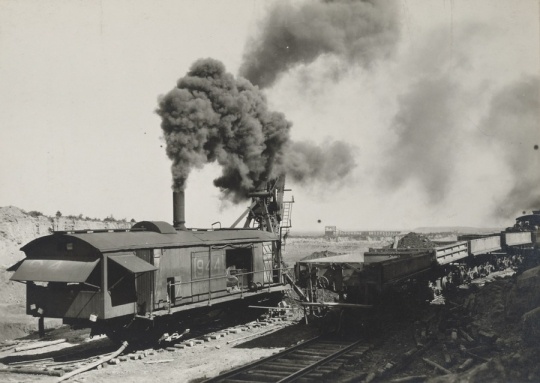
Oliver Mining Company steam-powered shovel near Hibbing
Oliver Mining Company steam-powered shovel near Hibbing, 1919. In this method of mining, a shovel removes overburden, the rock and soil that covers the ore body, so that miners can access the ore from the open pit.
Public domain
Holding Location
Articles
More Information
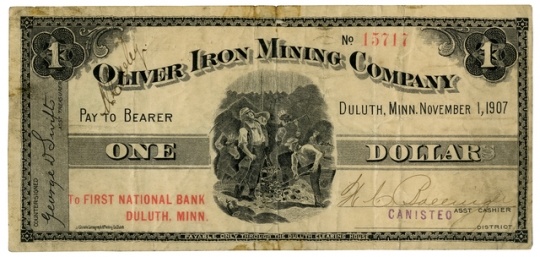
Oliver Mining Company $1.00 scrip note
Oliver Mining Company $1.00 scrip note. This note was used as currency in the communities near the mines that OMC operated. The bill features an image of miners working in a mine, and the bill was issued in the Canisteo District in 1907.
All rights reserved
Holding Location
Articles
More Information
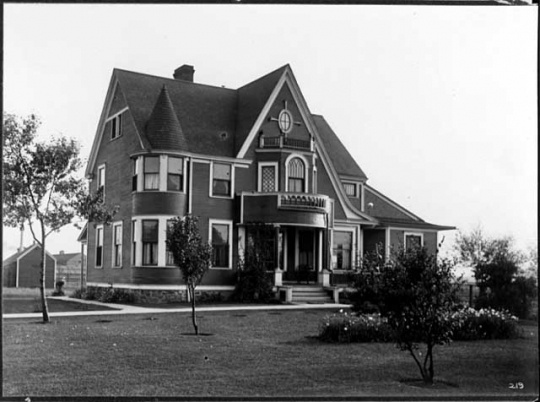
Home of the General Superintendent of the Oliver Mining Company
Home of the General Superintendent of the Oliver Mining Company in Hibbing, ca. 1913.
Public domain
Holding Location
Articles
More Information
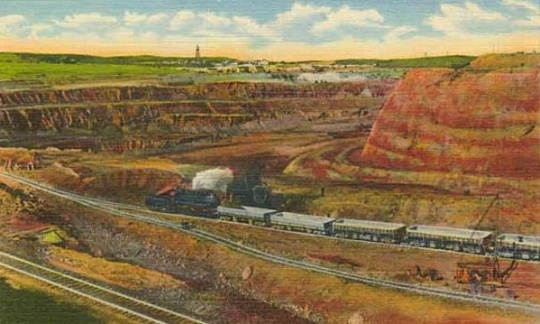
Missabe Mountain open pit mine, Franklin
Postcard of the Missabe Mountain open pit mine in Franklin, c.1915.
Public domain
Holding Location
More Information
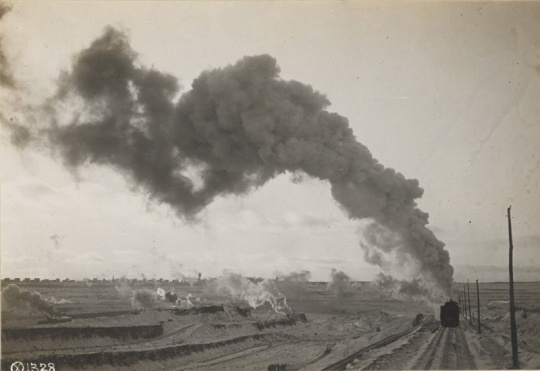
Oliver Mining Company locomotive
An Oliver Mining Company locomotive hauls ore away from an open pit near Hibbing, Minnesota, 1917. The young city is visible in the background.
Public domain
Holding Location
Articles
More Information
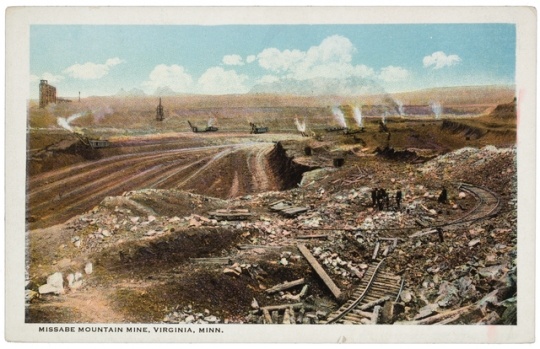
Missabe Mountain Mine, Virginia
Missabe Mountain Mine, Virginia, ca. 1920. The mine was the first to be purchased by Henry Oliver and it formed the backbone on which Oliver Mining Company was built. In 2019, the it is part of the Rouchleau pit complex.
Public domain
Holding Location
Articles
More Information
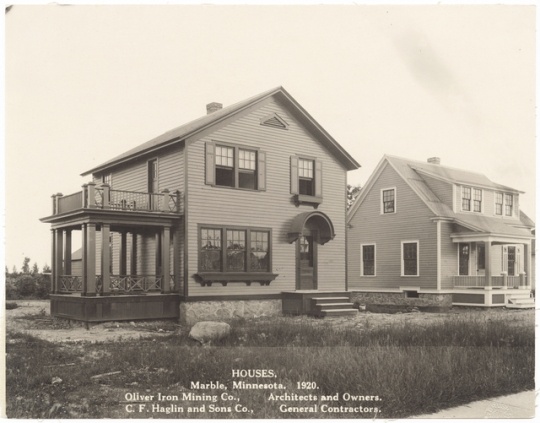
Oliver Mining Company-built homes in Marble
Oliver-built homes in Marble, Minnesota, 1920. The company designed and built homes in in the Canisteo District for employees to live in as they populated towns throughout the western Mesabi Range.
Public domain
Holding Location
Articles
More Information
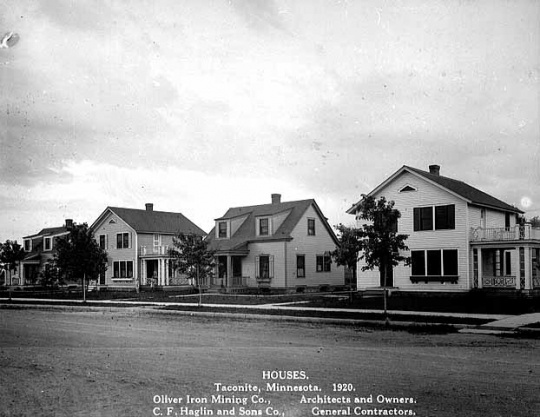
Oliver Mining Company-built homes in Taconite
Oliver-built homes in Taconite, 1920. Similar to those built in Marble, Oliver built homes in nearby Taconite to accommodate for the growing Canisteo District population and workforce.
Public domain
Holding Location
Articles
More Information
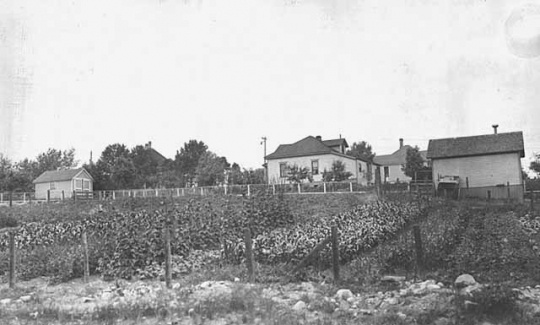
Oliver Mining Company employee gardens
Oliver Mining Company employee gardens, 1923. Oliver Mining Company allowed employees to plant and harvest from gardens within their communities. This garden was located in Fayal Location, near Eveleth.
Public domain
Holding Location
Articles
More Information
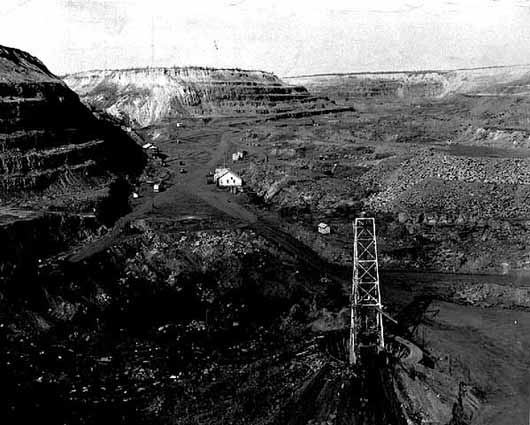
Spruce Mine
Mining at the Spruce Mine in Eveleth, ca. 1940. The Spruce Mine was one of many Oliver-controlled mines throughout the Mesabi Iron Range.
Public domain
Holding Location
Articles
More Information
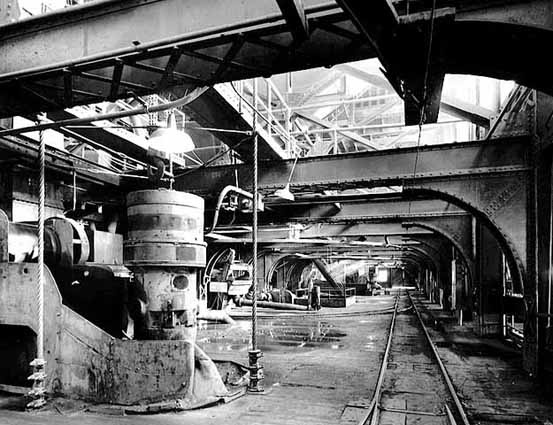
Trout Lake Concentrator
Inside the Trout Lake Concentrator, Oliver’s large ore beneficiation plant located in the Canisteo District of the Mesabi Iron Range (Coleraine, Minnesota), ca. 1940.
Public domain
Holding Location
Articles
More Information
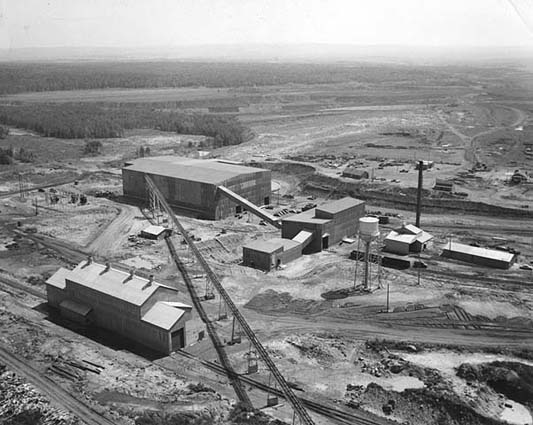
Pilotac, an experimental taconite-concentrating plant
Pilotac, an experimental taconite concentrating plant built by the Oliver Mining Division of United States Steel. The plant went into operation at Mountain Iron in 1953 as Minnesota Ore Operation’s Minntac plant.
Public domain
Holding Location
More Information
Related Articles
Turning Point
On February 23, 1901, United States Steel is incorporated as John D. Rockefeller, Andrew Carnegie, and Henry Oliver formalize an earlier agreement that had split up Mesabi Range operations. Oliver Iron Mining Company, as a division of USS, came to dominate the early Iron Range mining industry thanks to its massive capital foundation provided by the world’s first billion-dollar corporation.
Chronology
1890
1892
1894
1896
1901
1904
1907
1909
1916
1919
1940
1950
1967
2003
Bibliography
Eleff, Robert M. “The 1916 Minnesota Miners’ Strike Against U.S. Steel.” Minnesota History 51, no. 2 (Summer 1988): 63–74.
http://collections.mnhs.org/MNHistoryMagazine/articles/51/v51i02p063-074.pdf
Lamppa, Marvin G. Minnesota’s Iron Country: Rich Ore, Rich Lives. Duluth: Lake Superior Port Cities Press, 2004.
Torreano, Peter F. Mesabi Miracle: The 100–Year History of the Pillsbury–Bennett–Longyear Association. Hibbing: Sargent Land Company, 1991.
United States Steel Corporation. The Iron Key: In Observance of the Fiftieth Anniversary of Iron Ore Beneficiation in Minnesota, 1907–1957. Duluth: United States Steel Corporation, 1957.
——— . “Iron Ore of the Future.” Published pamphlet. Duluth: United States Steel Corporation, 1963.
——— . “This is Pilotac...An Experimental Taconite Plant.” Published pamphlet. Duluth: United States Steel Corporation, 1955.
——— . “Welcome to the Minnesota Iron Ore Country.” Published pamphlet. Duluth: United States Steel Corporation, 1953.
Walker, David A. Iron Frontier: The Discovery and Early Development of Minnesota’s Three Ranges. St. Paul: Minnesota Historical Society Press, 1979.
Related Resources
Primary
Davis, E. W. Pioneering with Taconite. St. Paul: Minnesota Historical Society Press, 1964.
KFM5803 1964
Pamphlets Relating to 1964 Taconite Amendment to the Minnesota State Constitution, 1964
Pamphlets Collection, Minnesota Historical Society, St. Paul
Description: Pamphlets promoting the 1964 Taconite Amendment and outlining questions that voters might have about the proposal.
Oliver Iron Mining Division. Jâwendâgosiwin (Opportunity). Duluth: United States Steel Corporation, 1956.
Oliver Iron Mining Company Research Files, 1860–1972
Manuscripts Collection, Minnesota Historical Society, St. Paul
Description: Materials documenting the operations of the Oliver Iron Mining Company on the Mesabi and Vermilion ranges, compiled by James S. Steel, an Oliver Iron Mining Company employee.
http://www2.mnhs.org/library/findaids/00181.xml
Oliver Iron Mining Company (1892–1964)
Archives and Special Collections, University of Minnesota, Duluth
Description: Files and records related to Oliver Iron Mining Company’s operations on the Mesabi Iron Range. Files include equipment and administrative records.
https://archives.lib.umn.edu/repositories/22/resources/8733
United States Steel Corporation. US Steel News. Hoboken, NJ: United States Steel Corporation, 1936–1957. Available at the Minnesota Historical Society library as TS300 .U62.
Secondary
Betten, Neil. “Riot, Revolution, Repression in the Iron Range Strike of 1916.” Minnesota History 41, no. 2 (Summer 1968): 82–94.
http://collections.mnhs.org/MNHistoryMagazine/articles/41/v41i02p082-094.pdf
Boese, Donald L. John C. Greenway and the Opening of the Western Mesabi. Grand Rapids, MN: Itasca Community College Foundation, 1975.
Chernow, Ron. Titan: The Life of John D. Rockefeller, Sr. New York: Random House, 1998.
Lavigne, David. “Rebel Girls: Women in the Mesabi Iron Range Strike of 1916.” Minnesota History 65, no. 3 (Fall 2016): 90–100.
http://collections.mnhs.org/MNHistoryMagazine/articles/65/v65i03p90-100.pdf
Manuel, Jeffrey T. Taconite Dreams: The Struggle to Sustain Mining on Minnesota’s Iron Range, 1915–2000. Minneapolis: University of Minnesota Press, 2015.
Thompson, Pamela M. Iron Range Country: A Historical Travelogue of Minnesota’s Iron Ranges. Eveleth, MN: Iron Range Resources and Rehabilitation Board, 1979.
Warren, Kenneth. Big Steel: The First Century of the United States Steel Corporation, 1901–2001. Pittsburgh: University of Pittsburgh Press, 2008.
Web
Missabe Railroad Historical Society.
https://www.missabe.com/













